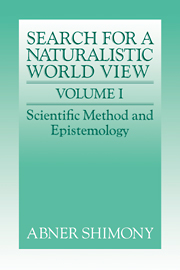Book contents
- Frontmatter
- Contents
- Acknowledgments
- A THE DIALECTIC OF SUBJECT AND OBJECT
- 1 Integral epistemology
- 2 Reality, causality, and closing the circle
- 3 Search for a worldview which can accommodate our knowledge of microphysics
- B PERCEPTION AND CONCEPTION
- C EPISTEMIC PROBABILITY
- D INDUCTIVE INFERENCE: THE DIALECTIC OF EXPERIENCE AND REASON
- E FACT AND VALUE
- Index
3 - Search for a worldview which can accommodate our knowledge of microphysics
Published online by Cambridge University Press: 21 December 2009
- Frontmatter
- Contents
- Acknowledgments
- A THE DIALECTIC OF SUBJECT AND OBJECT
- 1 Integral epistemology
- 2 Reality, causality, and closing the circle
- 3 Search for a worldview which can accommodate our knowledge of microphysics
- B PERCEPTION AND CONCEPTION
- C EPISTEMIC PROBABILITY
- D INDUCTIVE INFERENCE: THE DIALECTIC OF EXPERIENCE AND REASON
- E FACT AND VALUE
- Index
Summary
CONTRIBUTION OF THE NATURAL SCIENCES TO A WORLDVIEW
In a sense every human being with rudimentary intelligence has a worldview, that is, a set of attitudes on a wide range of fundamental matters. A philosophical worldview must be more than this, however. It must be articulate, systematic, and coherent. A philosophical worldview may be naturally subdivided into at least the following parts: (1) a metaphysics, which identifies the types of entities constituting the universe (possibly organizing them into a hierarchy, with some fundamental and others derivative), and which in addition asserts fundamental principles, such as those of cause and chance, that govern these entities; (2) an epistemology, concerned with the assessment of human claims to knowledge or justified belief; (3) a theory of language; and (4) a theory of ethical and aesthetic values. For reasons of professional training and preoccupation, and also of relevance to this collection of essays, I shall confine my comments almost entirely to metaphysics and epistemology.
A necessary condition for the coherence of a philosophical worldview is the meshing of its metaphysics and its epistemology. The metaphysics should be capable of understanding the existence and the status of subjects like ourselves who are capable of deploying the normative procedures of epistemology. And the epistemology should suffice to account for the capability of human beings to achieve something like a good approximation to knowledge of metaphysical principles, in spite of the spatial and temporal limitations of our experience and the flaws and distortions of our sensory and cognitive apparatus.
- Type
- Chapter
- Information
- The Search for a Naturalistic World View , pp. 62 - 76Publisher: Cambridge University PressPrint publication year: 1993
- 3
- Cited by



